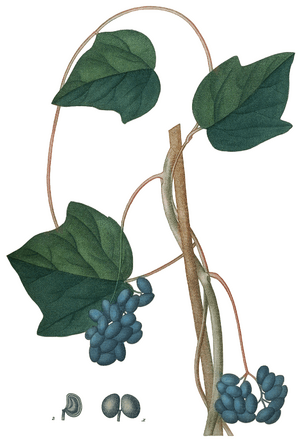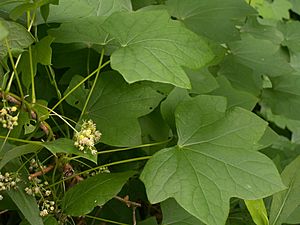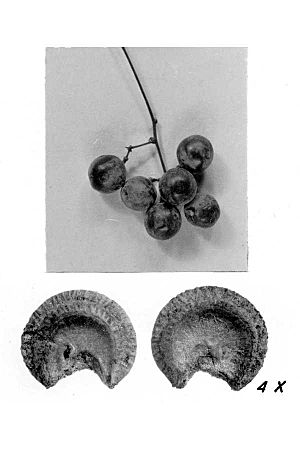Canadian moonseed facts for kids
Quick facts for kids Canadian moonseed |
|
|---|---|
 |
|
| Menispermum canadense | |
| Conservation status | |
| Scientific classification | |
| Genus: |
Menispermum
|
| Species: |
canadense
|
| Synonyms | |
|
|
The Canadian moonseed (scientific name: Menispermum canadense) is a type of flowering plant. It belongs to the Menispermaceae family. You can find this plant growing naturally in eastern North America. Its home ranges from southern Canada down to northern Florida. It also stretches from the Atlantic coast west to Manitoba and Texas. This plant often grows in thickets, wet woods, and along stream banks. It is also known as the common moonseed or yellow parilla.
Contents
What Does Canadian Moonseed Look Like?
The Canadian moonseed is a woody vine that climbs. It can grow quite tall, reaching up to 6 meters (about 20 feet). Its leaves are shaped like a hand with fingers spread out. They are usually 5–20 centimeters (2–8 inches) wide. Each leaf has 3 to 7 shallow rounded parts, called lobes. Sometimes, the leaves are just round without any lobes.
The plant produces small, round berries. These berries grow in clusters that are 6–10 centimeters (2.5–4 inches) wide. Each berry is about 1–1.5 centimeters (0.4–0.6 inches) across. They turn a purplish-black color when ripe. Inside each berry, there is a single seed. This seed looks like a crescent moon, which is how the plant got its common name. The berries are usually ripe between September and October. This is around the same time that wild grapes are ready to pick.
The Canadian moonseed has a root system called a rhizome. This means that one plant can spread underground. It can create many new plants that are all genetically the same.
Why Is Canadian Moonseed Dangerous?
It is very important to know that all parts of the Canadian moonseed plant are poisonous. This includes the leaves, stems, and especially the berries. The main harmful substance in the plant is called dauricine. Eating the berries can be very dangerous and even deadly.
The berries of the Canadian moonseed look a lot like wild grapes. This can be confusing for people who are looking for wild grapes to eat. However, there are some key differences to help you tell them apart:
- Seeds: Moonseed berries have only one seed, and it is shaped like a crescent moon. Wild grapes have several round seeds inside each berry.
- Taste: Moonseed berries have a very unpleasant taste. Wild grapes taste sweet or tart.
- Vines: Moonseed vines do not have tendrils. Tendrils are thin, curly parts that help a vine climb. Wild grape vines have branched tendrils.
Always be very careful when picking wild berries. Never eat any wild plant unless a trusted adult who knows plants well tells you it is safe.
How Was Canadian Moonseed Used?
Even though it is poisonous, the Canadian moonseed has been used for different purposes in the past. Native American tribes used this plant in traditional medicine. The Cherokee people used the moonseed root to help with digestion, like a laxative. They also used the root to treat skin problems. The Lenape tribe made a special cream, called a salve, from the plant. They used this salve to help heal sores on the skin. People of European descent in the Americas also used the plant for various medicinal reasons.
See also
 In Spanish: Menispermum canadense para niños
In Spanish: Menispermum canadense para niños




